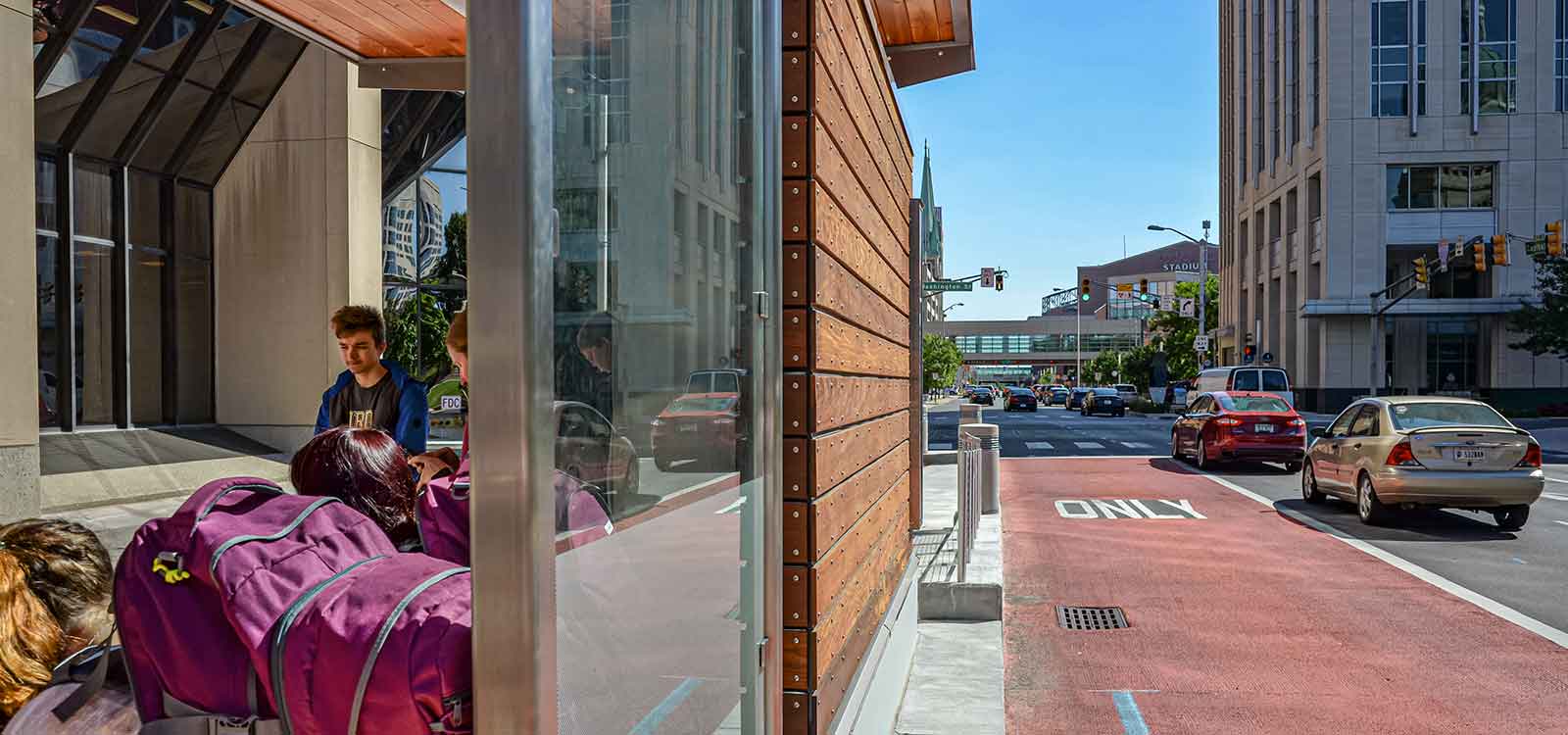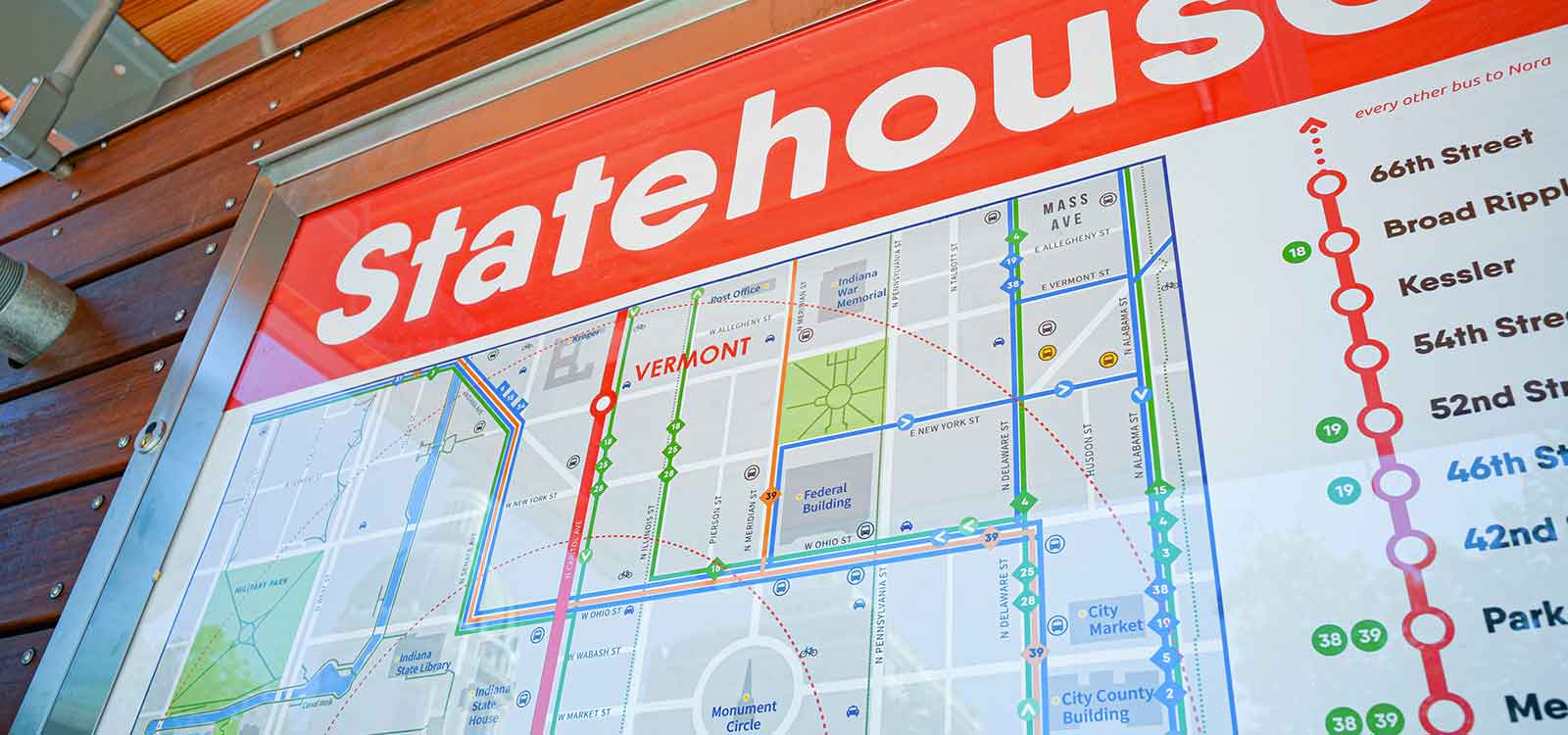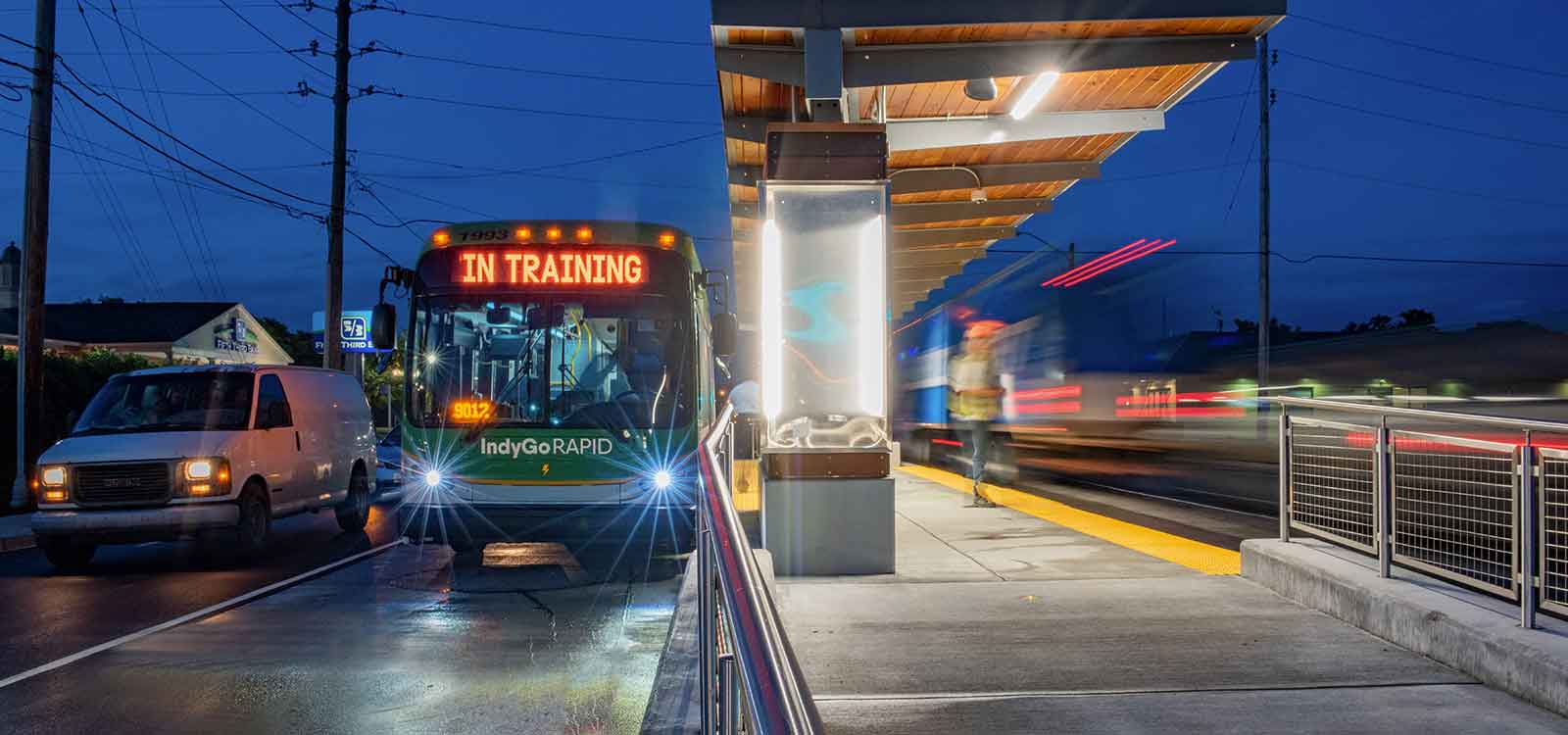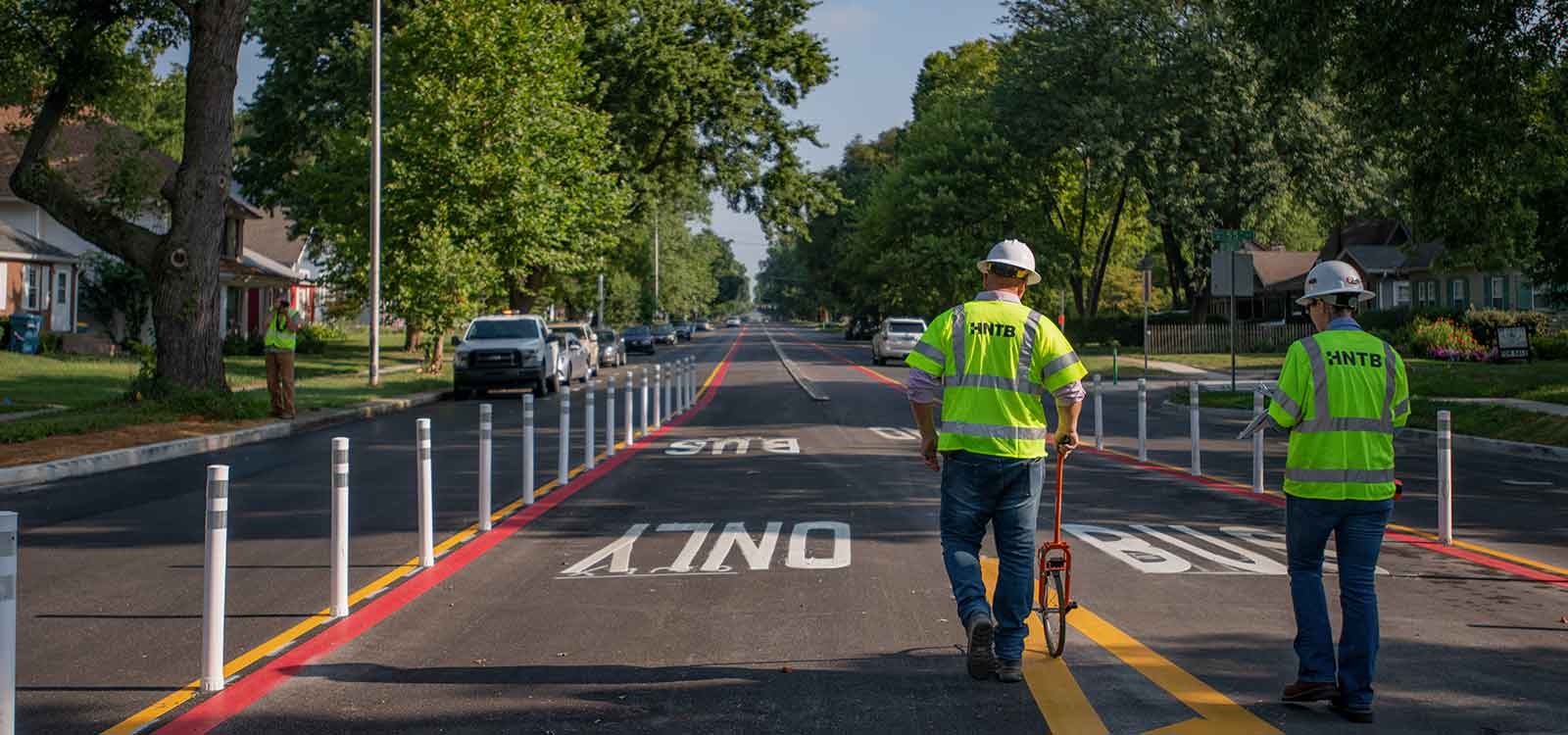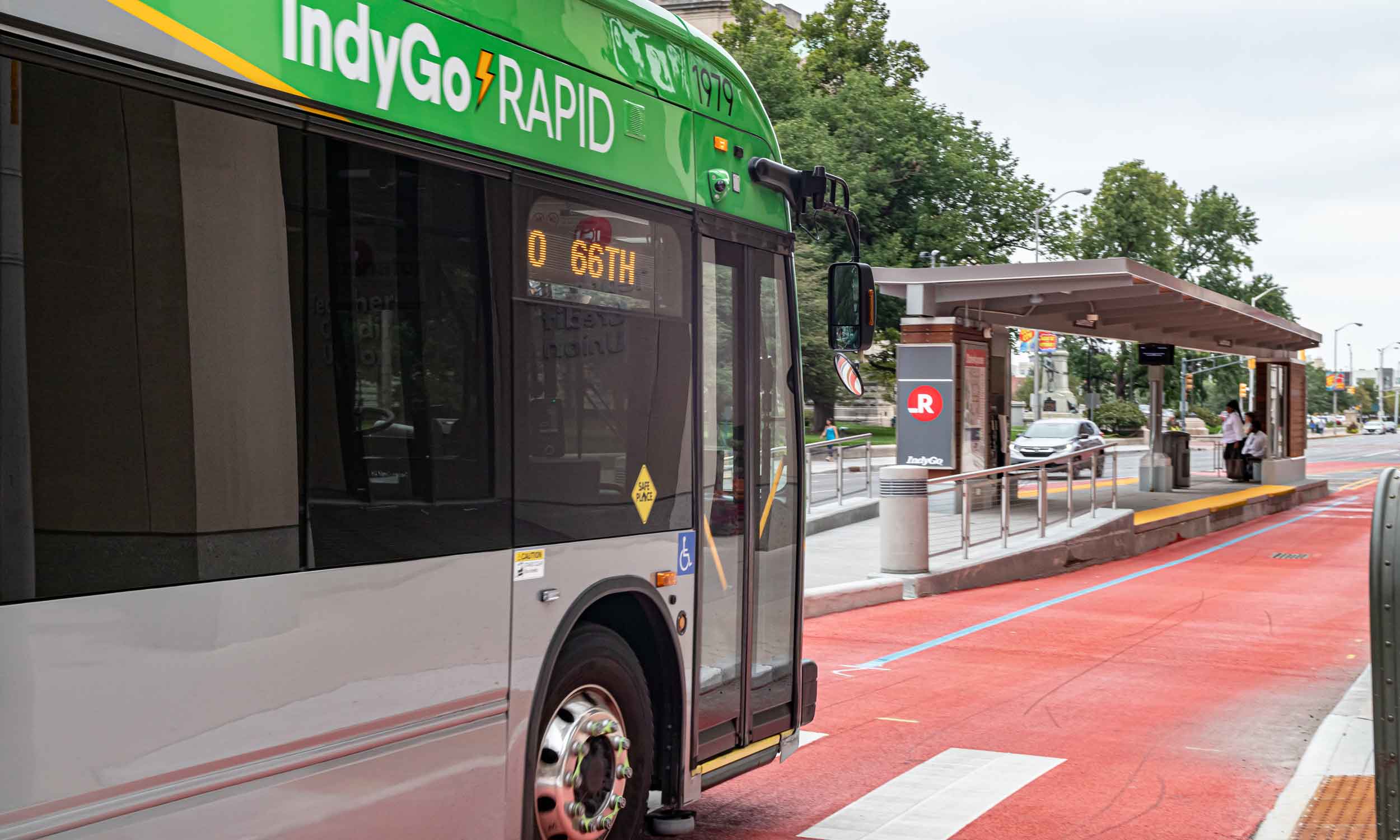
Rapid Ride on Red Line
HNTB helps IndyGo conquer 13.1 miles of busy urban corridor
to deliver Indiana’s first BRT Line under budget and two months
ahead of schedule.
DESIGNER
2021
When the Indianapolis Public Transportation Corporation (IndyGo) set a goal to deliver the state’s first bus rapid transit (BRT) line, it turned to HNTB for construction management and inspection services.
IndyGo envisioned a 13.1-mile BRT line that would improve travel on one of the city’s busiest urban corridors by providing an alternate mode of travel to popular cultural districts, the Indianapolis University Health Center, the state capitol and the University of Indianapolis.
The challenges Evans speaks of were numerous — from creating a competitive bidding environment and meeting an ambitious Disadvantaged Business Enterprise goal to overcoming a six-month funding delay and hundreds of utility conflicts. In the end, IndyGo would give the public what it asked for — and paid for — its first BRT line, delivered under budget and two months ahead of schedule.
“The Red Line was the largest and most innovative project IndyGo had ever undertaken while also implementing a transit tax referendum. It was important to have an experienced expert construction management team backing us to overcome the challenges ahead,”
said IndyGo CEO Inez Evans.
Creating contractor interest
“Our local contractors weren’t familiar with bus rapid transit and its unique components,” said Jennifer Pyrz, PE, IndyGo chief development officer and vice president of infrastructure, strategy and innovation.
HNTB then turned its attention to the bid phase. The Red Line was the state’s first major transit project in public right of way, 60% of the alignment would have dedicated lanes with center or offset stations. In addition to building the BRT infrastructure, the winning contractor would have to resurface roadways and reconstruct curbs and sidewalks. Few, if any, local contractors had experience in both areas.
“Advertising the Red Line as a single construction contract was a risk,” said Mike Stair, HNTB project manager. “So, we split the project into two low-bid packages: a roadway and civil engineering construction package and a stations, communications and security construction package, to increase the bid pool.”
Contractors were invited to bid on one or both packages. HNTB assisted the agency in reviewing three proposals and preparing contract documents. In December 2017, IndyGo awarded two contracts — one for each package.
“The winning bids came in low enough that IndyGo was able to add additional amenities to the station platforms like snowmelt systems,” Pyrz said.
More to come
The Red Line will serve as the backbone of IndyGo’s BRT system with a Purple Line and Blue Line planned in the coming years. IndyGo is proceeding with development of the $155 million Purple Line, a 15.2 mile east-west arm off the Red Line. By the first quarter of 2021, the agency hopes to have design 100% complete and ready to bid. The Blue Line, a 24-mile east-west route that will connect downtown to the Indianapolis International Airport, was at 30% design at the time this article was written. Service on the Purple Line is expected to open at the end of 2023 with construction of the Blue Line to begin right after that.
Combating extensive delays
Everything was in place to begin the project, except for federal funding. When IndyGo did receive the $75 million Federal Transit Administration grant in May 2018 and gave notice to proceed, the project was six months behind schedule. Worse, once construction began, contractors found unexpected underground conditions that threatened further delays.
“There were hundreds of utility conflicts, and because the alignment passes through some of the oldest areas of the city, crews encountered basements and odd structures no one knew existed,” Stair said.
Fact
Red Line is served by a modern fleet of 13 articulated, battery-electric buses.
Transit Tax
Marion County’s Transit Plan is supported by a 2016 voter-approved transit tax. The plan includes extensive improvements to local transit routes and the addition of three BRT lines.
New features at Red Line stations
IndyGo re-examined the conventional “bus stop,” and made quantum-leap changes. Each of the Red Line’s new rapid-transit stations feature:
- New in-median locations
- Ticket-vending machines (cash/credit/debit) that speed the boarding process
- A digital marquee displaying real-time arrival information for the next bus
- Step-free station access in accordance with the American Disabilities Act
- Flush, step-free, bus-height boarding platforms
- Well-lit boarding areas, security cameras and “blue-light” emergency phones
- Wind screens and drip-free roof eaves for better weather protection
To keep the project moving forwarding, HNTB and the designer of record worked together to identify about 200 locations where additional subsurface exploration was conducted.
“Every time we found a new conflict, we would redesign the area within a few days. We resolved several hundred conflicts that way,” Stair said.
HNTB teamed with the city’s Department of Public Works to help expedite work with utility companies and to impress upon them the importance of the project.
“We also developed a Google map, so our partners on the job could see the location of each conflict, its status and when it would be resolved,” Stair said.
Accelerating the project
With a timeline showing utility conflicts would not be resolved until February 2019, IndyGo and HNTB began talking in late 2018 about the possibility of accelerating construction to get the project back on schedule. It would require significant change management, but with HNTB’s help, IndyGo could do it.
HNTB asked both contractors to pull together costs and schedules that would have the line substantially completed by July 31, 2019. HNTB reviewed the proposals, negotiated change orders and approved schedules. The final agreements outlined milestone incentives and allowed crews to work up to seven days a week, including nighttime shifts.
Contractors began executing the expedited plan on Feb. 1, 2019. HNTB helped determine the best means and methods for completing concrete work, foundation prep, and other activities typically not performed during winter.
At the peak of construction, 32 teams were working on the project. Relying heavily on the DBE community, HNTB recruited 12 more inspectors to keep pace with construction.
“We completed almost 80% of the project between March and July 2019,” Pyrz said.
By the end of July 2019, the Red Line was substantially complete, as planned.
Despite the unanticipated acceleration expenses, HNTB was able to keep the project within budget thanks to a $25 million contingency fund established at the firm’s recommendation prior to construction.
“HNTB’s experience in mega projects and projects controls was key in helping us manage the $96.3 million budget, coordinate schedules and create independent cost estimates,” said Tom Spragg, construction manager for IndyGo.
DBEs play a major role success of the project
- HNTB’s construction management team’s commitment was 20% and increased it to 26.8% participation
- Package A’s commitment was 12.34% and ended with more than 15% participation
- Package B’s commitment was 1.72% ended with more than 2% participation
Managing urban construction
The densely populated corridor also presented maintenance of traffic challenges. To minimize the impact, HNTB collaborated with the city and first responders to adjust construction schedules and traffic configurations for the greater public good. As an added value, the firm led an extensive public involvement effort to educate citizens about temporary construction impacts and IndyGo’s efforts to mitigate them.
“Carving out space for a BRT lane in Indianapolis’ densest urban area was, in some ways, more difficult than putting in a new highway,” Stair said. “More than 50,000 residents and nearly 150,000 jobs are within a quarter mile of the line. You have a lot more eyes on you — and more impact on the public — in urban areas.”
Fortunately, HNTB’s outreach coordinator was an engineer on the construction team. She took public concerns and inquiries directly to the construction team, and together, they answered the question or solved the problem.
“Many issues were resolved while the citizen or business owner was on the phone,” Jennifer Pyrz said. “Having the ability to fix the issue on the spot was an enormous benefit.”
Welcoming a new era
On Labor Day 2019, when the Red Line went live, residents lined up at each of the 28 stations, eagerly awaiting the new experience.
“An experienced construction manager, with the right depth and mix of resources, HNTB helped us overcome significant roadblocks and usher in a bold, new era of efficient, rider-focused BRT in Indianapolis,” Evans said. “Our transit system not only takes us to our destinations, it takes our city to its future.”
SEE MORE ARTICLES
US 290 Program
INDYGO RED LINE
CASEY ARBORWAY
ALLEGIANT STADIUM
CHAMP CLARK BRIDGE
ORLANDO INTERNATIONAL AIRPORT, SOUTH TERMINAL

